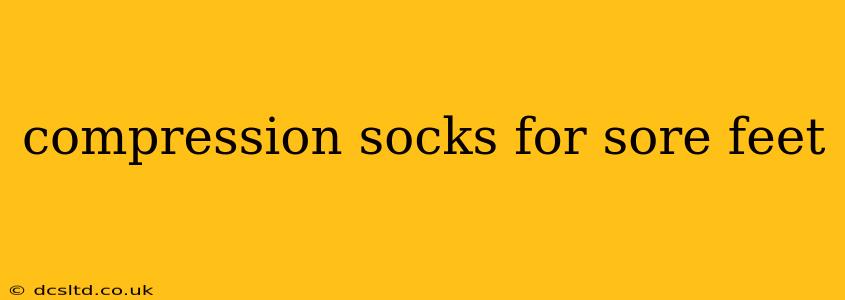Sore feet can significantly impact your daily life, hindering activity and causing discomfort. Many people turn to compression socks as a potential solution, and for good reason. This comprehensive guide explores the benefits of compression socks for sore feet, addressing common questions and offering insights into their effective use. We'll delve into the science behind their effectiveness, different types available, and how to choose the right pair for your needs.
Do Compression Socks Help with Sore Feet?
Yes, compression socks can offer significant relief for various causes of sore feet. The gentle pressure they exert on your feet and ankles improves circulation, reducing swelling and inflammation. This enhanced blood flow helps deliver oxygen and nutrients to the tissues, aiding in faster recovery from physical activity or injury. For those with conditions like plantar fasciitis, the support provided by compression socks can also help alleviate pain and discomfort.
What Kind of Compression Socks Are Best for Sore Feet?
The best type of compression sock for sore feet depends on the underlying cause and severity of your pain. Generally, socks with a graduated compression profile (higher compression at the ankle, gradually decreasing towards the calf) are recommended. This design promotes better blood flow back to the heart.
- Light Compression (8-15 mmHg): Ideal for everyday wear, mild swelling, or general fatigue. Good for prevention and mild discomfort.
- Medium Compression (15-20 mmHg): Suitable for moderate swelling, mild to moderate plantar fasciitis, and recovery after moderate activity.
- Firm Compression (20-30 mmHg): Best for significant swelling, severe plantar fasciitis, and recovery from strenuous activity or injury. Consult a doctor before using firm compression.
Note: Always consult a doctor or healthcare professional before using compression socks, especially if you have underlying health conditions like diabetes or circulatory issues.
How Do Compression Socks Help with Plantar Fasciitis?
Plantar fasciitis, a common cause of heel pain, results from inflammation of the plantar fascia, a thick band of tissue on the bottom of the foot. Compression socks can help manage plantar fasciitis by:
- Reducing Inflammation: Improved circulation helps reduce swelling and inflammation in the plantar fascia.
- Providing Support: The gentle compression offers support to the arch and heel, lessening strain on the plantar fascia.
- Improving Blood Flow: Enhanced blood flow accelerates healing and reduces pain.
Are Compression Socks Good for Foot Swelling?
Yes, compression socks are highly effective in reducing foot swelling (edema). The compression helps to push excess fluid back towards the heart, reducing fluid buildup in the lower extremities. This is particularly beneficial for people who spend long hours standing or sitting, pregnant women, and individuals with conditions that cause fluid retention.
Can I Wear Compression Socks to Bed?
While generally safe, wearing compression socks to bed is a matter of personal preference and comfort. Some individuals find them beneficial for overnight swelling reduction, while others find them restrictive and uncomfortable for sleep. If you choose to wear them to bed, opt for lighter compression levels to avoid discomfort.
How Long Should I Wear Compression Socks for Sore Feet?
The duration of wear depends on the individual's needs and the severity of their condition. For mild discomfort, a few hours of wear may suffice. For more severe conditions, wearing them for a larger portion of the day might be beneficial. Always follow the manufacturer's instructions and consult a healthcare professional for personalized recommendations. Listening to your body is crucial; if you experience any discomfort, remove the socks immediately.
What are the potential downsides of wearing compression socks?
While generally safe and beneficial, wearing compression socks does have potential downsides. These include:
- Discomfort: Some people find them too tight or uncomfortable, particularly if they are wearing a higher compression level.
- Skin Irritation: Improperly fitting socks can restrict blood flow and cause skin irritation. Ensure proper fit and breathable material.
- Increased Risk of Blood Clots (rare): In rare instances, overly tight compression can increase the risk of blood clots. This is more likely if you have pre-existing conditions.
By carefully selecting the appropriate compression level and material, and by paying close attention to your body's response, you can effectively use compression socks to alleviate sore feet and promote healing. Remember, consulting a healthcare professional is always recommended for persistent or severe foot pain.
